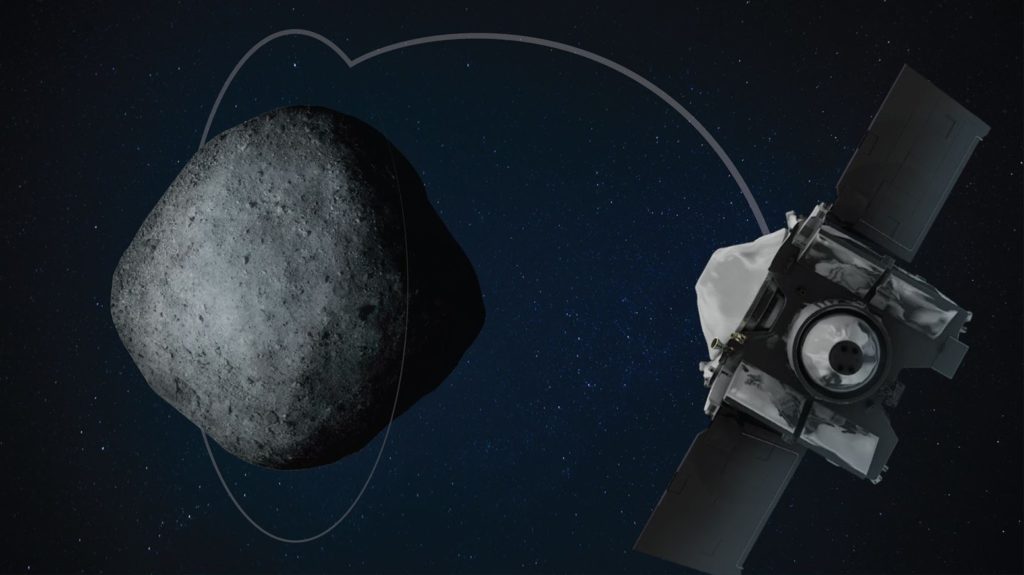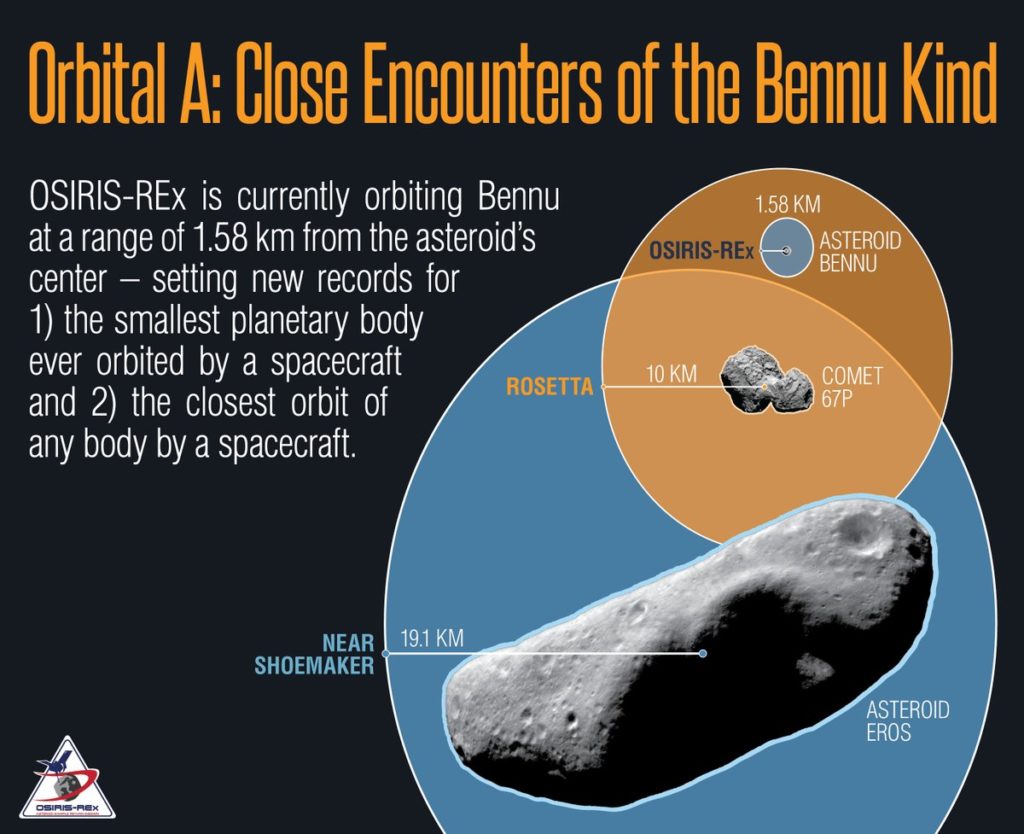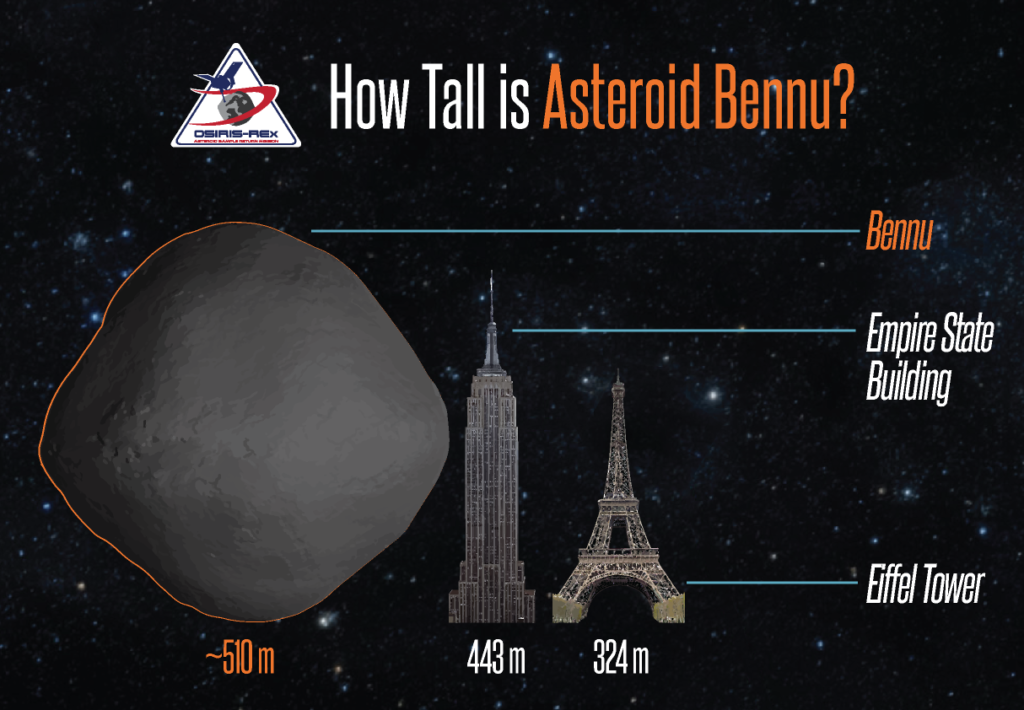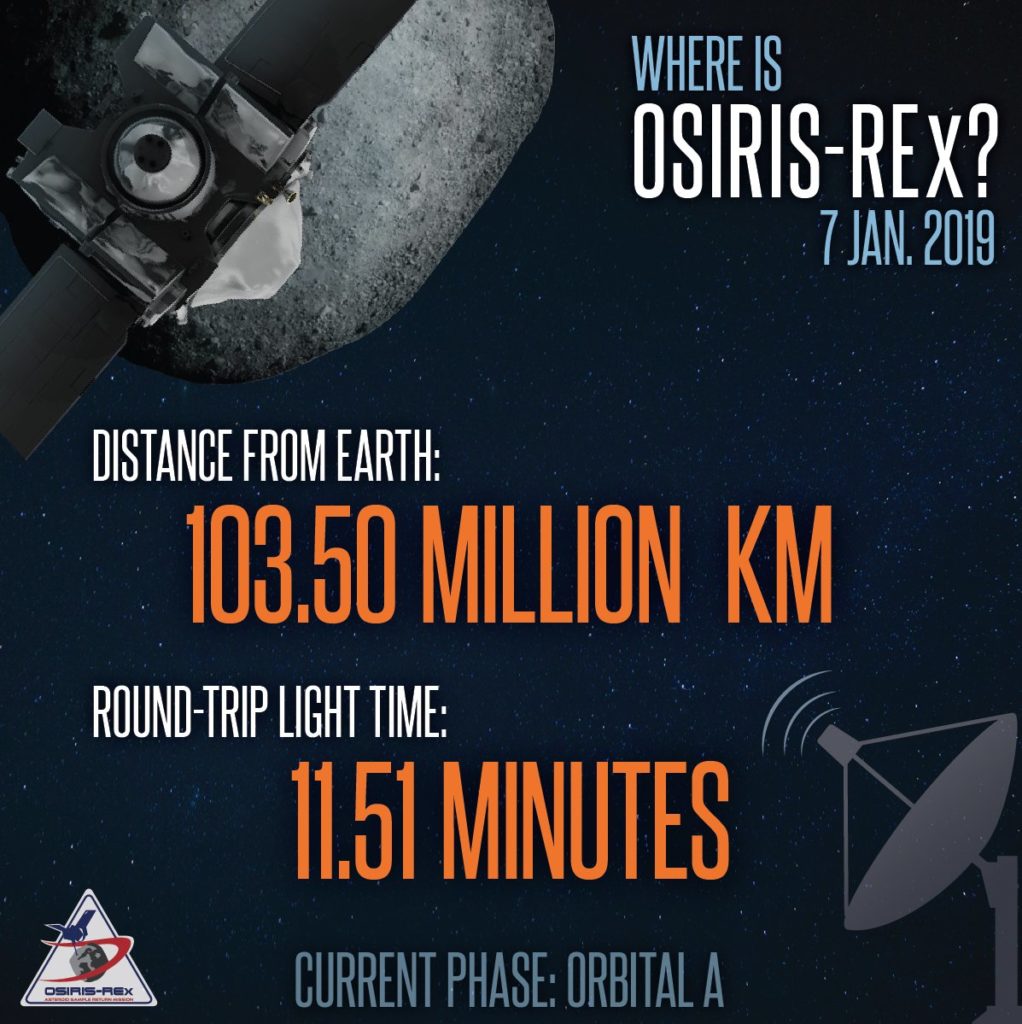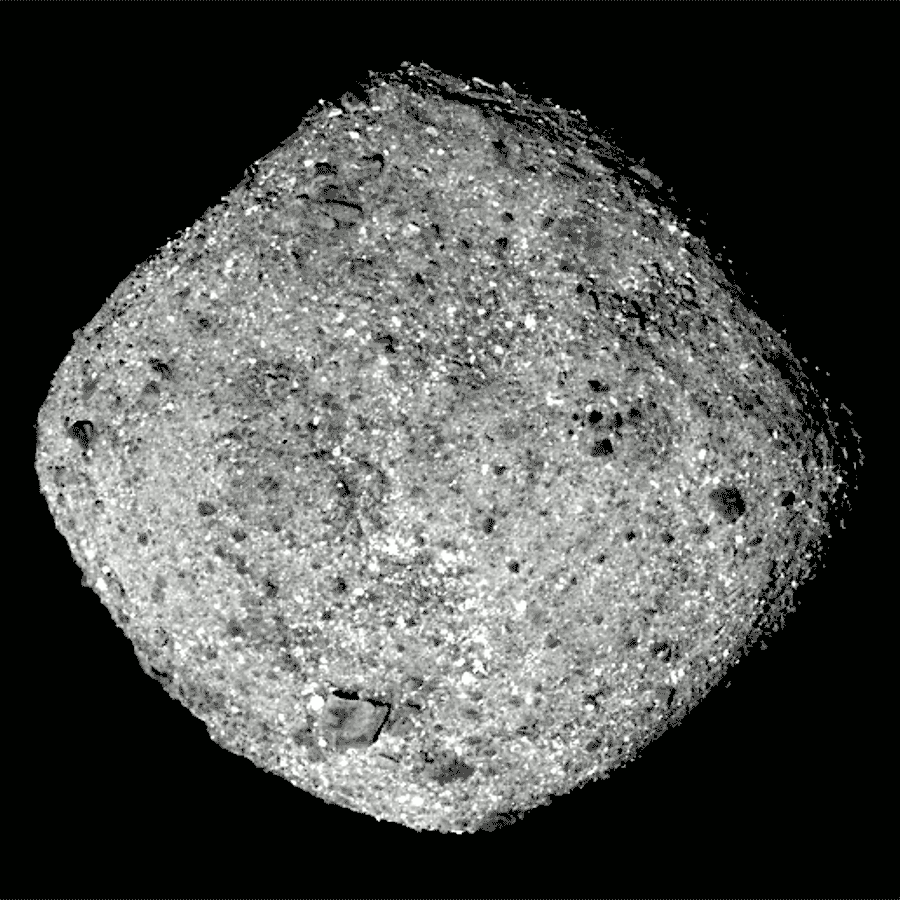RocketSTEM –17 January 2019
CAPE CANAVERAL, FL – Just hours before the stroke of New Years midnight NASA’s OSIRIS-REx spacecraft fired its thrusters for a single, eight-second burn and successfully achieved
orbit around its destination, asteroid Bennu at 2:43 p.m. EST on December 31,
2018 at a distance of 70 million miles (110 million kilometers) away from
Earth.
NASA’s Origins, Spectral
Interpretation, Resource Identification, Security-Regolith Explorer
(OSIRIS-REx) spacecraft thereby broke a space exploration record as Bennu
became the smallest object ever to be orbited by a
spacecraft from Earth at a range of approximately
1 mile (1.57 km) from the asteroid’s center.
Bennu is estimated to be about 0.3 miles (510 meters) tall,
just a bit longer than the Empire State Building in New York City which is 443
meters tall.
Thus Bennu also simultaneously became the smallest
object ever orbited – even tinier than the prior record holder comet
67P/Churyumov-Gerasimenko orbited by ESA’s Rosetta spacecraft about
four miles (seven kilometers) from its center in May 2016.
“It’s
official! I’m in orbit around #asteroid Bennu —
now the smallest body ever orbited by a spacecraft. My snug path around the
asteroid also sets a new record for the closest orbit of a planetary body by
any spacecraft,” she tweeted from her official twitter account on New Years Eve.
The fateful event came after a two year and over
two billion kilometer (1.2 billion mile) interplanetary journey by OSIRIS-REx
to the near-Earth asteroid Bennu.
The OSIRIS-Rex arrival at Bennu also counted as the first
phase of a truly remarkable and unprecedented double header for NASA Planetary
Science at
opposite ends of our Solar System. The second play being the successful close flyby by NASA’s New Horizons spacecraft of Ultima Thule far out in the Kuiper Belt over 4 Billion miles (6.4
Billion km) from Earth moments after midnight on New Years Day 2019.
“The team continued our
long string of successes by executing the orbit-insertion maneuver perfectly,”
said Dante Lauretta, OSIRIS-REx principal investigator at the University of
Arizona, Tucson, in a statement.
campaign coming to an end, we are looking forward to the scientific mapping and
sample site selection phase of the mission.”
Lauretta, along with his
team, spent the last day of 2018 with his feet planted on Earth, but his mind
focused on space. “Entering orbit around Bennu is an amazing accomplishment
that our team has been planning for years,” Lauretta said.
A” phase of the mission. It now begins the
initial survey of the asteroid using its suite of five science instruments – leading
towards the ultimate goal of collecting soil and rock samples at a safe and
scientifically interesting site for return to Earth September 2023.
The science team and
engineering team at the University of Arizona and spacecraft prime contractor Lockheed
Martin continues working through the ongoing government shutdown. They are releasing new imagery and graphics.
However postdocs have
just been furloughed as NASA funding runs out.
The team recently posted these 2 graphics on Jan. 7 showing
the spacecrafts location:
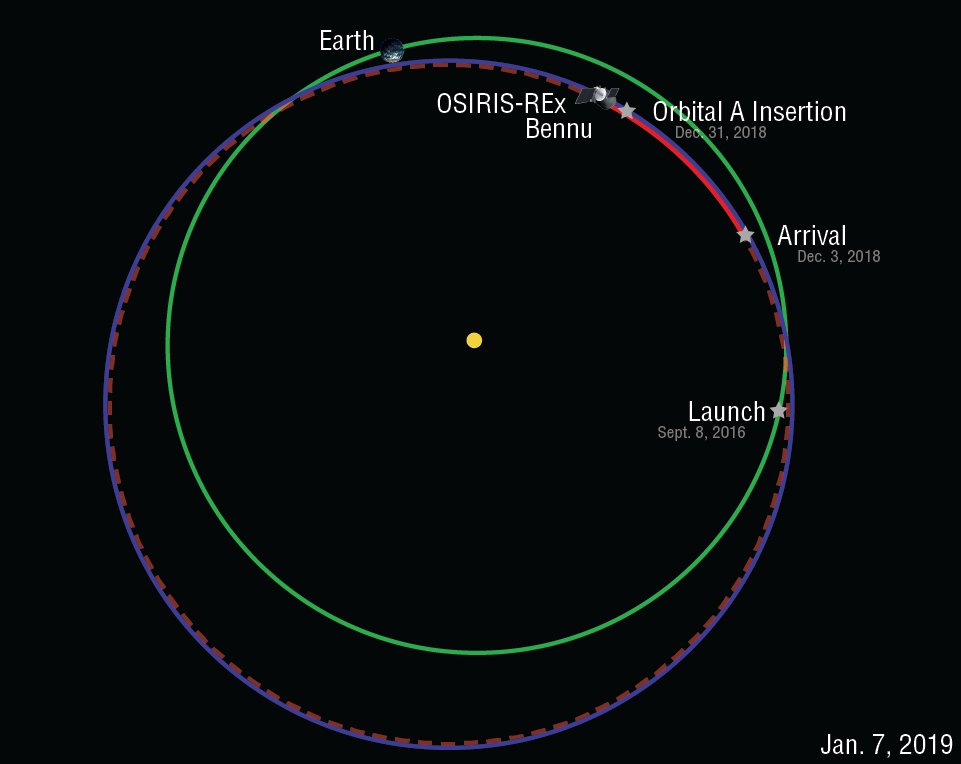 |
| OSIRIS-REx spacecraft location |
Here are the details from NASA:
Inching around the
asteroid at a snail’s pace, OSIRIS-REx’s first orbit marks a leap for
humankind. Never before has a spacecraft from Earth circled so close to such a
small space object – one with barely enough gravity to keep a vehicle in a
stable orbit.
Now, the spacecraft will
circle Bennu about a mile (1.75 kilometers) from its center, closer than any
other spacecraft has come to its celestial object of study. (Previously the
closest orbit of a planetary body was in May 2016, when
the Rosetta spacecraft orbited about four miles (seven kilometers) from the
center of the comet 67P/Churyumov-Gerasimenko.) The comfortable distance is
necessary to keep the spacecraft locked to Bennu, which has a gravity force
only 5-millionths as strong as Earth’s.
The spacecraft is scheduled to orbit
Bennu through mid-February at a leisurely 62 hours per orbit.
Now that the OSIRIS-REx
spacecraft is closer to Bennu, physical details about the asteroid will leap
into sharper focus, and the spacecraft’s tour of this rubble pile of primordial
debris will become increasingly detailed and focused.
“Our orbit design is
highly dependent on Bennu’s physical properties, such as its mass and gravity
field, which we didn’t know before we arrived,” said OSIRIS-REx’s flight
dynamics system manager Mike Moreau, who is based at NASA’s
Goddard Space Flight Center in Greenbelt, Maryland.
“Up until now, we had to
account for a wide variety of possible scenarios in our computer simulations to
make sure we could safely navigate the spacecraft so close to Bennu. As the
team learned more about the asteroid, we incorporated new information to hone
in on the final orbit design,” he said.
Dec. 31, 2018, NASA’s OSIRIS-REx spacecraft entered orbit around asteroid Bennu
— setting new records for the smallest body ever orbited by a spacecraft and
the closest orbit of a planetary body by any spacecraft. OSIRIS-REx will remain
in orbit until mid-February 2019 when the spacecraft will begin a series of
flybys that allow it to conduct a more detailed survey of the asteroid’s
surface. It will enter orbit a second time in mid-2019. Credit: NASA
The simulations have
played a critical role. The OSIRIS-REx mission, after all, was designed based
on complex computer programs that predicted — quite accurately, as it turns out
— the properties of Bennu and how the spacecraft’s trajectory would behave.
This diligent preparation allowed the team to navigate the vehicle safely to
Bennu in December and put some questions to rest (there are, indeed, signs of ancient water preserved in
Bennu’s rocks) and to fly over its poles and equator in a preliminary survey
that led to some surprises (Bennu has many large boulders).
Having completed the
preliminary survey of Bennu with a flyby of its south pole on December 16, the
spacecraft moved to a safe 31 miles (50 kilometers) away from the asteroid to
give the navigation team a chance to regroup and prepare for orbit insertion.
Next, Lockheed Martin engineers programmed the spacecraft to begin moving back
to a position about nine miles (15 kilometers) over Bennu’s north pole to
prepare for three burns of its thrusters over the course of 10 days that would
place the spacecraft into orbit.
Even though OSIRIS-REx
is in the most stable orbit possible, Bennu’s gravitational pull is so tenuous
that keeping the spacecraft safe will require occasional adjustments, said Dan
Wibben, OSIRIS-REx maneuver and trajectory design lead at KinetX Aerospace in
Simi Valley, California.
“The gravity of Bennu is
so small, forces like solar radiation and thermal pressure from Bennu’s surface
become much more relevant and can push the spacecraft around in its orbit much
more than if it were orbiting around Earth or Mars, where gravity is by far the
most dominant force,” he said.
The OSIRIS-REx
navigation team will use “trim” maneuvers to slightly thrust the spacecraft in
one direction or another to correct its orbit and counter these small forces.
If the spacecraft drifts away from Bennu, or some other problem forces it into
safe mode, it has been programmed to fly away from the asteroid to stay safe
from impact.
“It’s simple logic:
always burn toward the Sun if something goes wrong,” said Coralie Adam,
OSIRIS-REx lead optical navigation engineer at KinetX. Engineers can navigate
the spacecraft back into orbit if it drifts away, Adam said, though that’s
unlikely to happen.
The navigation and
spacecraft operations teams are focused on the first orbital phase. Their
primary goal is to transition away from star-based navigation, which allowed
the team to locate the spacecraft based on pictures of the star formations
around it taken by the cameras onboard. Navigators use methods like
this since there is no GPS in deep space and we can’t see the spacecraft from
Earth-based telescopes. From this point forward, though, the OSIRIS-REx team
will rely on landmarks on Bennu’s surface to track OSIRIS-REx, a more precise
technique that will ultimately guide them to a sample-collection site clear of
boulders and large rocks, said Adam.
“After conducting a
global imaging and mapping campaign during our recent preliminary survey phase,
the science team has created 3-D models of Bennu’s terrain that we’re going to
begin using for navigation around the asteroid,” she said.
Another critical
objective of this orbital phase, Adam said, is to get a better handle on
Bennu’s mass and gravity, features that will influence the planning of the rest
of the mission, notably the short touchdown on the surface for sample
collection in 2020. In the case of Bennu, scientists can only measure these
features by getting OSIRIS-REx very close to the surface to see how its
trajectory bends from Bennu’s gravitational pull.
“The Orbital A phase
will help improve our detailed models for Bennu’s gravity field, thermal
properties, orientation, and spin rate,” said Wibben. “This, in turn, will
allow us to refine our trajectory designs for the even more challenging flight
activities we will perform in 2019.”
The December 31 maneuver
to place the spacecraft into orbit about Bennu is the first of many exciting
navigation activities planned for the mission. The OSIRIS-REx team will resume
science operations in late February. At that point, the spacecraft will perform
a series of close flybys of Bennu for several months to take high-resolution
images of every square inch of the asteroid to help select a sampling site.
During the summer of 2020, the spacecraft will briefly touch the surface of
Bennu to retrieve a sample. The OSIRIS-REx mission is scheduled to deliver the
sample to Earth in September 2023.
….
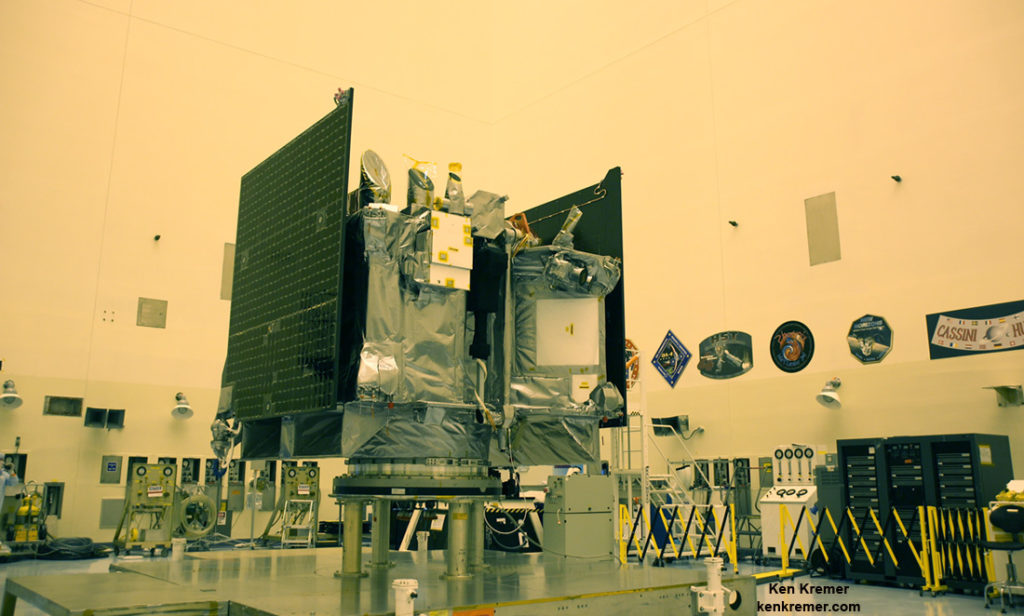 |
|
OSIRIS-Rex spacecraft in KSC cleanroom prior to
launch Sept 2016 from pad 41 on Cape Canaveral Air Force Station, FL. Credit: Ken Kremer/kenkremer.com/spaceupclose.com |
Watch for Ken’s
continuing onsite coverage of NASA, SpaceX, ULA, Boeing, Lockheed Martin,
Northrop Grumman and more space and mission reports direct from the Kennedy Space
Center, Cape Canaveral Air Force Station, Florida and Wallops Flight Facility,
Virginia.
Stay tuned here for Ken’s continuing Earth and Planetary science
and human spaceflight news: www.kenkremer.com –www.spaceupclose.com – twitter
@ken_kremer – email: ken at kenkremer.com
Dr. Kremer is a research scientist,
journalist and photographer based in the KSC area.
Ken’s photos are for sale and he is available for lectures and outreach events


